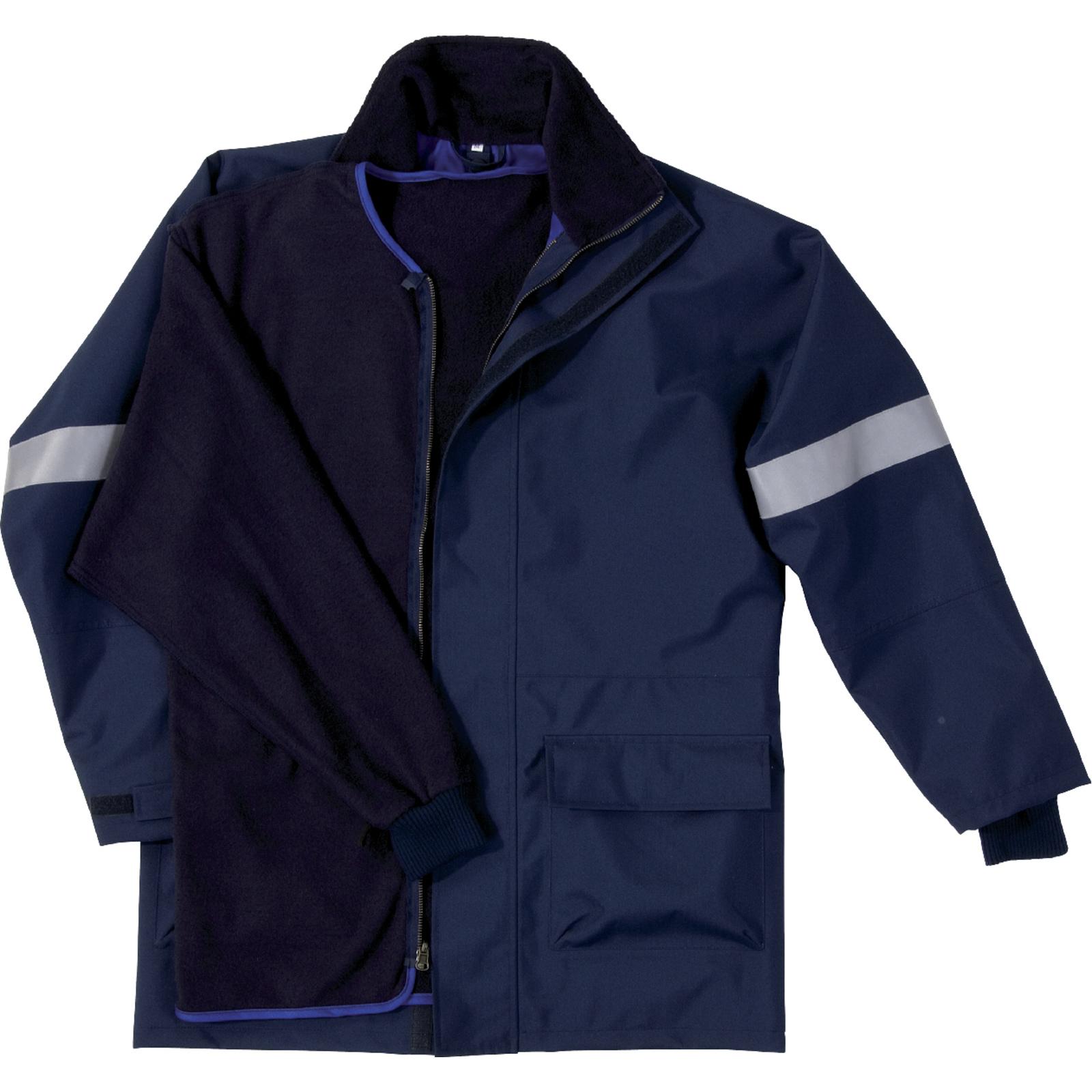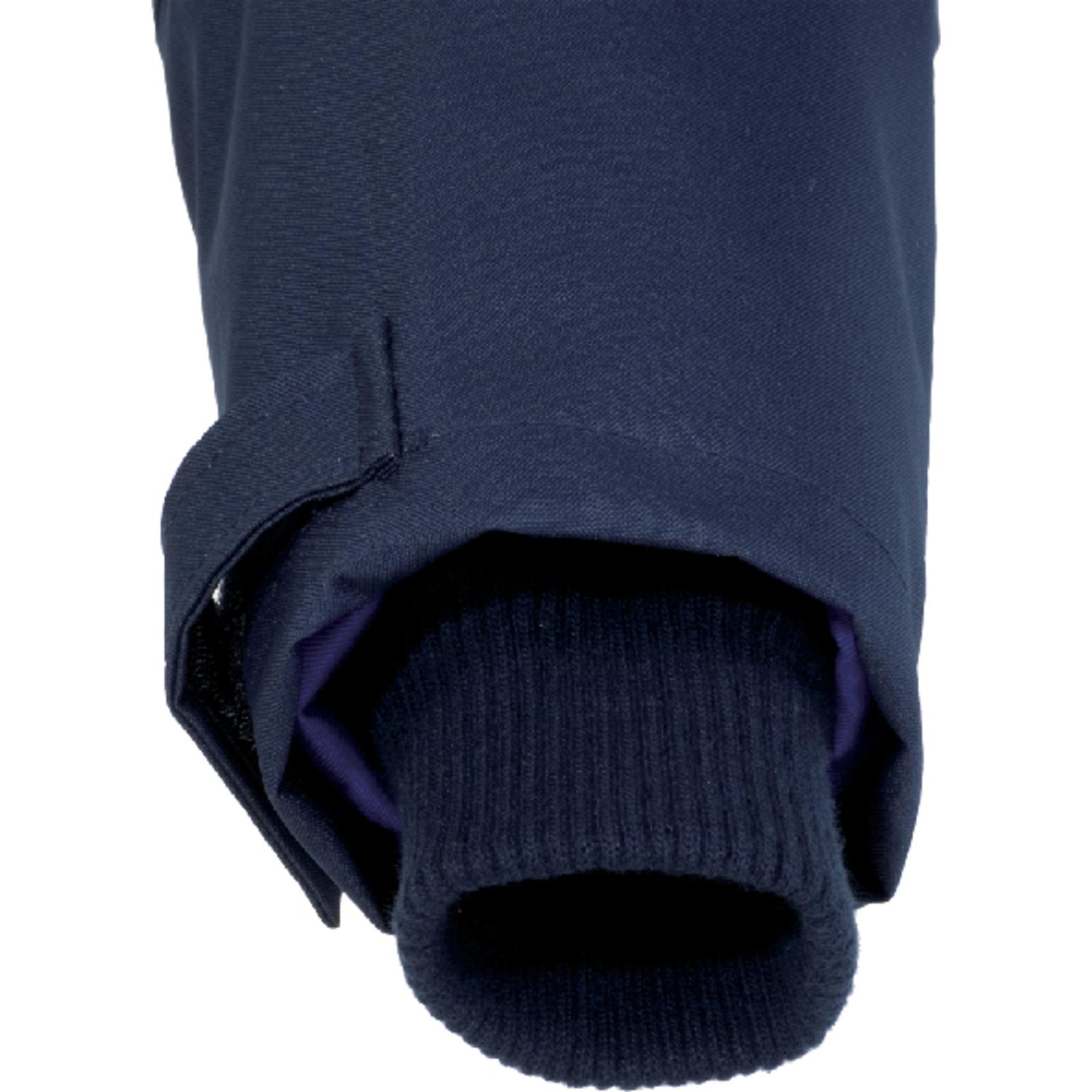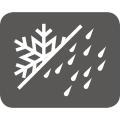The product complies with the European Directive 89/686, notably regarding ergonomics, innocuousness, comfort and with standards :
PU-COATED POLYESTER / ANTISTATIC FIBRE PROTECTIVE PARKA
2 in 1 rain warm parka: Removable jacket. Parka : Waterproof seams. Fastening with zip under flap. Removable jacket : Zip fastening. Knitted cuffs. 3 pockets.
Polyurethane-coated 98% polyester 2% antistatic fibre fabric.
100% flame retardant cotton fixe lining.
100% polyester polar fleece removable lining.
Loxy® retro-reflective sewn bands.
15/02/16

Removable Polar fleece lining (CE CAT 1)
KOMODO - KOMODO HV

Internal knitted cuff
KOMODO - KOMODO HV
| Reference |
pcb |
Colour |
Size |
| KOMODBMPT |
5 |
Navy blue |
S |
| KOMODBMTM |
5 |
Navy blue |
M |
| KOMODBMGT |
5 |
Navy blue |
L |
| KOMODBMXG |
5 |
Navy blue |
XL |
| KOMODBMXX |
5 |
Navy blue |
XXL |
| KOMODBM3X |
5 |
Navy blue |
3XL |
| KOMODBM4X |
5 |
Navy blue |
4XL |
EN340:2003 General requirements Reference standard, not for use alone, but only in association with another standard containing the protection performance requirements.
This standard specifies general performance requirements for ergonomics, innocuousness, size designation, durability, ageing, compatibility and marking of protective clothing and the information to be supplied by the manufacturer with the protective clothing.
EN13034:2005+A1:2009 Performance requirements for chemical protective clothing offering limited protective performance against liquid chemicals (Type 6 equipment) - Limited protection against liquid chemicals Type 6
- Limited protection against liquid chemicals + biological protection Type6B
- PB (6) Limited protection against liquid chemicals + biological protection type (PB) 6 - partial body protection
EN ISO14116:2008 Protective clothing - Protection against heat and flamme - 1/25H/40 Index of resistance of outside shell (from 1 to 3) Nb washes I (Industrial) or H (domestic) / T°C
EN1149-5:2008 Electrostatic properties - Part 5: Material performance and design requirements - Surface resistivity inferior or equal to 2.5x10⁹ Ohms on one surface at least following EN1149-1
- t50 <4s or S> 0.2 by method 2 ( charging by induction) of EN1149-3
This European Standard specifies requirements for materials and the design of protective electrostatic dissipation clothing used in conjunction with a grounded system in order to prevent incendiary discharges.
WARNING: These requirements may be insufficient in oxygen enriched flammable environments. This standard is not applicable for protection against mains voltages. The control of undesirable static electricity on the person is often necessary.
The electrostatic potential may, indeed, have serious consequences on the charged individual, because it can be high enough to cause dangerous sparks.
After a risk assessment, the wearing of protective electrical dissipation clothing may be necessary. The use of clothing certified according to EN1149-5 is then adapted.
The ATEX Directive 1999/92/EC, in its Annex II-A-2.3, requests that workers be equipped with work clothes made of materials that do not produce electrostatic discharges that can ignite explosive environments.
The electrostatic potential can also affect equipment sensitive to electric discharge. And antistatic clothing are often used on electronic manufacturing sites, assembling semiconductors for example. Finally, they are used on sites with controlled atmospheres such as automotive paint workshops, to avoid the emission of particles that may be deposited on the body paint.
The antistatic charge dissipation can be provided by a process limiting the build up of charge, or by adding carbon or metal wires. People wearing protective electrostatic charge dissipation clothing must always be grounded with a resistance of less than 10⁸Ω, for example, by wearing appropriate footwear such as the safety shoes stated in EN ISO 20345, or by other suitable means.
EN343:2003 A1:2007 Protective garment against rain exposures - 3 Resistance of the Penetration of water (1 to 3)
- Resistance of the Penetration of water (1 to 3) - Parka
- 2 Evaporative resistance (1 to 3)
This standard specifies the requirements and test methods applicable to the materials and seams of protective clothing against foul weather (for example precipitation in the form of rain or snow), fog and ground humidity.
• THERMAL RESISTANCE (Rct) IN M².K/W :
Measurement of the thermal insulation provided.
Divided into 3 classes (from 1 to 3) from the least insulating to the most insulating. The higher the value, the greater the thermal insulation.
• WATER VAPOUR RESISTANCE (Ret) IN (M².PA)/W :
Measures the evaporative resistance, i.e. the product’s obstacle to the passage of water vapour, or the barrier it offers to evaporation of transpiration on the surface of the skin. The higher a product’s water vapour resistance, the greater this product’s barrier to the passage of water vapour: A breathing product has a low water vapour resistance. Divided into 3 classes (from 1 to 3) from the least breathable to the most breathable.
• AIR PERMEABILITY (AP) IN mm/s :
Determines the complex’s permeability to air.
Divided into 3 classes (from 1 to 3) from the least airtight to the most airtight.
• RESISTANCE TO WATER PENETRATION (WP) IN PASCAL:
Measurement of the outer material and seams’ resistance to water penetration under a water pressure of (980+/-50) Pa/min.
Divided into 3 levels (1 to 3) from the least impermeable to the most impermeable.
• RESULTANT EFFECTIVE THERMAL INSULATION:
Measured on moving dummy (/cler) or on non moving dummy (/cle).
The thermal insulation coefficient, expressed in m2.K/W, is used to determine the optimum usage temperature of the garment in relation to the individual’s activity and his exposure time.
Thermal insulation is measured with undergarments of type :
– (B) for ensembles (Undershirt with long sleeves, long underpants, socks, bootee + thermojacket, thermopants, knitted gloves, balaclava).
– (R) for garments (Undershirt with long sleeves, long underpants, socks, bootees, jacket, trousers, shirt, knitted gloves, balaclava).
– (C) provided by the manufacturer.








